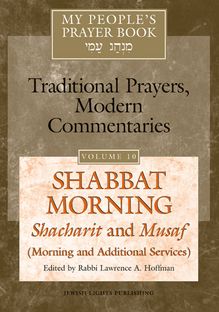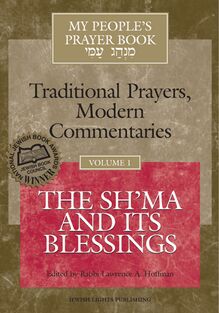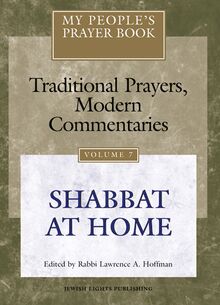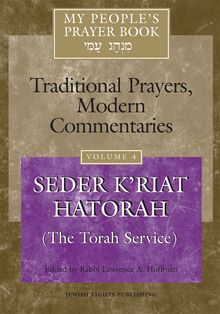My People's Prayer Book Vol 3 , livre ebook
170
pages
English
Ebooks
2013
Vous pourrez modifier la taille du texte de cet ouvrage
Obtenez un accès à la bibliothèque pour le consulter en ligne En savoir plus
Découvre YouScribe et accède à tout notre catalogue !
Découvre YouScribe et accède à tout notre catalogue !
170
pages
English
Ebooks
2013
Vous pourrez modifier la taille du texte de cet ouvrage
Obtenez un accès à la bibliothèque pour le consulter en ligne En savoir plus
Publié par
Date de parution
28 mai 2013
Nombre de lectures
5
EAN13
9781580237567
Langue
English
"The prayer book is our Jewish diary of the centuries, a collection of prayers composed by generations of those who came before us, as they endeavored to express the meaning of their lives and their relationship to God. The prayer book is the essence of the Jewish soul."
This stunning work, an empowering entryway to the spiritual revival of our times, enables all of us to claim our connection to the heritage of the traditional Jewish prayer book. It helps rejuvenate Jewish worship in today's world, and makes its power accessible to all.
This third volume of the series explores the rich content and meaning of the P'sukei D’zimrah, the morning psalms that serve as the introduction to the larger prayer service. The P’sukei D’zimrah sets the tone and prepares the way for the daily transition from secular routine to the sacred act of communal prayer; Vol. 3 helps us to appreciate this "prayer before the prayer" as a profoundly moving spiritual experience in its own right.
Vol. 3—P’sukei D’zimrah (Morning Psalms) features the authentic Hebrew text with a new translation designed to let people know exactly what the prayers say. Introductions tell the reader what to look for in the prayer service, as well as how to truly use the commentaries, to search for—and find—meaning in the prayer book. Commentaries from some of today’s most eminent scholars and teachers from all movements of Judaism examine P’sukei D’zimrah from the perspectives of ancient Rabbis and modern theologians, as well as feminist, halakhic, Talmudic, linguistic, biblical, Chasidic, mystical, and historical perspectives.
Even those not yet familiar with the prayer book can appreciate the spiritual richness of P’sukei D’zimrah. My People’s Prayer Book enables all worshipers, of any denomination, to encounter their own connection to 3,000 years of Jewish experience with the world and with God.
ABOUT MY PEOPLE'S PRAYER BOOK INTRODUCTION TO THE LITURGY: WHY THE P’SUKEI D’ZIMRAH? Lawrence A. Hoffman PRAYER IN THE BIBLE AND THE USE OF THE BIBLE IN LATER JEWISH PRAYER Marc Brettler. THE TWOFOLD HALAKHIC STATUS OF P’SUKEI D’ZIMRAH Daniel Landes P’SUKEI D’ZIMRAH AND THE PROBLEM OF LENGTH IN MODERN PRAYER BOOKS David Ellenson. ASHRE: PSALM 145 AND ITS RHETORICAL STRUCTURE Reuven Kimelman INTRODUCTION TO THE COMMENTARIES: HOW TO LOOK FOR MEANING IN THE PRAYERS Lawrence A. Hoffman THE LITURGY 1. OPENING BLESSING: BARUKH SHE’AMAR ("BLESSED IS THE ONE BY WHOSE SPEECH…") 2. BIBLICAL INTERLUDE I: MEDIEVAL ADDITIONS. A. 1 CHRONICLES 16:8–36 B. MIXTURE OF PSALM VERSES C. PSALM 100. D.MIXTURE OF BIBLICAL VERSES. 3. THE DAILY HALLEL (HALLEL SHEB’KHOL YOM): PSALMS 145–150. A. PSALM 145 (ASHRE). B. PSALM 146 C. PSALM 147 D. PSALM 148 E. PSALM 149 F. PSALM 150 4. BIBLICAL INTERLUDE II: MEDIEVAL ADDITIONS. A.MIXTURE OF PSALM VERSES B. 1 CHRONICLES 29:10–13 C.NEHEMIAH 9:6–11 D. SHIRAT HAYAM (“SONG OF THE SEA” [EXODUS 14:30–15:18]) 5. CLOSING BLESSING: YISHTABACH (“THE BLESSING OF SONG” [BIRKAT HASHIR] About the Commentators List of Abbreviations Glossary About Jewish Lights
Publié par
Date de parution
28 mai 2013
EAN13
9781580237567
Langue
English
R ead may be the wrong word. Engage would be better, because this is not so much a book as it is a classic text, and Jewish classics are not read so much as they are engaged. Included here is a classic text of Jewish prayer, spanning 2,000 years of Jewish experience with the world and with God; and nine thoughtful commentaries on that text, each one reaching back in a different way, again through 2,000 years of time. The question ought to be, Who should engage this book in personal dialogue?
If you like to pray, or find prayer services baffling: Whether you are Orthodox, Conservative, Reconstructionist, or Reform, you will find that My People s Prayer Book tells you what you need to know to pray. The Hebrew text here is the most authentic one we have, and the variations among the Jewish movements are described and explained. They are all treated as equally authentic. The translation is honest, altogether unique, and outfitted with notes comparing it to others translations. Of special interest is a full description of the Halakhah (the how to ) of prayer and the philosophy behind it.
If you are a spiritual seeker or Jewishly curious: If you have wondered what Judaism is all about, the prayer book is the place to begin. It is the one and only book that Jews read each and every day. The commentaries explain how the prayers were born, and synopsize insights of founding Rabbis, medieval authorities, Chasidic masters, and modern theologians. The layout replicates the look of Jewish classics: a text surrounded by many marginal commentaries allowing you to skip back and forth across centuries of insight.
If you are a teacher or a student: This is a perfect book for adult studies, or for youth groups, teenagers, and camps. Any single page provides comparative insight from the length and breadth of Jewish tradition, about the texts that have mattered most in the daily life of the Jewish people.
If you are a scholar: Though written in friendly prose, this book is composed by scholars: professors of Bible, Rabbinics, Medieval Studies, Liturgy, Theology, Linguistics, Jewish Law, Mysticism, and Modern Jewish Thought. No other work summarizes current wisdom on Jewish prayer, drawn from so many disciplines.
If you are not Jewish: You need not be Jewish to understand this book. It provides access for everyone to the Jewish wisdom tradition. It chronicles the ongoing Jewish-Christian dialogue, and the roots of Christian prayer in Christianity s Jewish origins.
The My People s Prayer Book: Traditional Prayers, Modern Commentaries series Volume 1- The Sh ma and Its Blessings 168 pp, 978-1-879045-79-8 Volume 2- The Amidah 240 pp, 978-1-879045-80-4 Volume 3- P sukei D zimrah (Morning Psalms) 240 pp, 978-1-879045-81-1 Volume 4- Seder K riat Hatorah (The Torah Service) 264 pp, 978-1-879045-82-8 Volume 5- Birkhot Hashachar (Morning Blessings) 240 pp, 978-1-879045-83-5 Volume 6- Tachanun and Concluding Prayers 240 pp, 978-1-879045-84-2 Volume 7- Shabbat at Home 240 pp, 978-1-879045-85-9 Volume 8- Kabbalat Shabbat (Welcoming Shabbat in the Synagogue) 240 pp, 978-1-58023-121-3 Volume 9- Welcoming the Night: Minchah and Ma ariv (Afternoon and Evening Prayer) 272 pp, 978-1-58023-262-3 Volume 10- Shabbat Morning: Shacharit and Musaf (Morning and Additional Services) 240 pp, 978-1-58023-240-1
Prayers of Awe Volume 1- Who by Fire, Who by Water- Un taneh Tokef 272 pp, 978-1-58023-424-5 Volume 2- All These Vows- Kol Nidre 288 pp, 978-1-58023-430-6 Volume 3- We Have SinnedSin and Confession in Judaism- Ashamnu and Al Chet 288 pp, 978-1-58023-612-6
My People s Passover Haggadah: Traditional Texts, Modern Commentaries Volume 1- 304 pp, 978-1-58023-354-5 Volume 2- 320 pp, 978-1-58023-346-0
INTRODUCTION TO THE LITURGY: WHY THE P SUKEI D ZIMRAH? LAWRENCE A. HOFFMAN
PRAYER IN THE BIBLE AND THE USE OF THE BIBLE IN LATER JEWISH PRAYER MARC BRETTLER
THE TWOFOLD HALAKHIC STATUS OF P SUKEI D ZIMRAH DANIEL LANDES
P SUKEI D ZIMRAH AND THE PROBLEM OF LENGTH IN MODERN PRAYER BOOKS DAVID ELLENSON
ASHRE : PSALM 145 AND ITS RHETORICAL STRUCTURE REUVEN KIMELMAN
INTRODUCTION TO THE COMMENTARIES: HOW TO LOOK FOR MEANING IN THE PRAYERS LAWRENCE A. HOFFMAN
THE LITURGY
1. OPENING BLESSING: BARUKH SHE AMAR ( BLESSED IS THE ONE BY WHOSE SPEECH ... )
2. BIBLICAL INTERLUDE I: MEDIEVAL ADDITIONS
A. 1 CHRONICLES 16:8-36
B. MIXTURE OF PSALM VERSES
C. PSALM 100
D. MIXTURE OF BIBLICAL VERSES
3. THE DAILY HALLEL (HALLEL SHEB KHOL YOM) PSALMS 145-150
A. PSALM 145 ( ASHRE )
B. PSALM 146
C. PSALM 147
D. PSALM 148
E. PSALM 149
F. PSALM 150
4. BIBLICAL INTERLUDE II: MEDIEVAL ADDITIONS
A. MIXTURE OF PSALM VERSES
B. 1 CHRONICLES 29:10-13
C. NEHEMIAH 9:6-11
D. SHIRAT HAYAM ( SONG OF THE SEA [EXODUS 14:30-15:18])
5. CLOSING BLESSING: YISHTABACH ( THE BLESSING OF SONG [BIRKAT HASHIR] )
About the Commentators
List of Abbreviations
Glossary
About the Editor
About My People s Prayer Book
Copyright
Also Available
About Jewish Lights
Sign Up for E-mail Updates
Send Us Your Feedback
L iturgy can seem confusing, more like a shapeless mass of verbiage than a carefully constructed whole; a jumble of noise, not a symphony; a blotch of random colors, hardly a masterpiece of art. But prayer is an art form, and like the other arts, the first step toward appreciation is to recognize the pattern at work within it.
There are three daily services: morning (Shacharit), afternoon (Minchah), and evening (Ma ariv or Arvit). For the sake of convenience, the latter two are usually recited in tandem, one just before dark, and the other immediately after the sun sets. All three follow the same basic structure, but the morning service is the most complete. It is composed of seven consecutive units that build upon each other to create a definitive pattern. Though the words of each unit have been fluid for centuries, the structural integrity of the service has remained sacrosanct since the beginning.
Services are made of prayers, but not all prayers are alike. Some are biblical quotations, ranging in size from a single line to entire chapters, usually psalms. There are rabbinic citations also, chunks of Mishnah or Talmud that serve as a sort of Torah study within the service. Medieval poetry occurs here too, familiar things like Adon Olam or older staples (called piyyuti m -sing., piyyut ) marked less by rhyme and rhythm than by clever word plays and alphabetic acrostics. And there are long passages of prose, the work again of medieval spiritual masters, but couched in standard rabbinic style without regard for poetic rules.
Most of all, however, the Siddur is filled with blessings, a uniquely rabbinic vehicle for addressing God, and the primary liturgical expression of Jewish spirituality.
Blessings (known also as benedictions, or, in Hebrew, b rakho t -sing., b rakhah ) are so familiar that Jewish worshipers take them for granted. We are mostly aware of short blessings, the one-line formulas that are customarily recited before eating, for instance, or before performing a commandment. But there are long blessings too, generally whole paragraphs or even sets of paragraphs on a given theme. These are best thought of as small theological essays on topics like deliverance, the sanctity of time, and the rebuilding of Jerusalem. They sometimes start with the words Barukh atah Adonai ... ( Blessed are You, Adonai ... ), and then they are easily spotted. But more frequently, they begin with no particular verbal formula and are hard to identify until their last line, which invariably does say, Barukh atah Adonai ... ( Blessed are You, Adonai ... ) followed by a short synopsis of the blessing s theme ( ... who sanctifies the Sabbath, ... who hears prayer, ... who redeems Israel, and so forth). This final summarizing sentence is called a chatimah, meaning a seal, like the seal made from a signet ring that seals an envelope.
The bulk of the service as it was laid down in antiquity consists of strings of blessings, one after the other, or of biblical quotations bracketed by blessings that introduce and conclude them. By the tenth century, the creation of blessings largely ceased, and eventually, Jewish law actually opposed the coining of new ones, on the grounds that post-talmudic Judaism was too spiritually unworthy to try to emulate the literary work of the giants of the Jewish past. Not all Jews agree with that assessment today, but the traditional liturgy that forms our text here contains no blessings later than the tenth century.
The word we use to refer to all the literary units in the prayer book, without regard to whether they are blessings, psalms, poems, or something else, is rubric . A rubric is any discrete building block of the service, sometimes a single prayer (this blessing rather than that, or this quotation but not that poem), and sometimes a whole set of prayers that stands out in contradistinction to other sets: The P sukei D zimrah, for instance (our topic here in Volume 3 of this series) is a large rubric, composed mostly of Psalms and other biblical citations, and bracketed by an introductory and a concluding benediction. Relative to the P sukei D zimrah as a whole, however, each of these two blessings (for instance) is a subrubric, but sometimes, when considered relative to each other, they may be called rubrics as well. The term is flexible. It is just a convenient way to refer to a particular body of material without having to stipulate what kind of thing-a psalm? a blessing? a piyyut ? -it is.
At the liturgy s core are three large rubrics: the Sh ma and Its Blessings (the topic of Volume 1 of this series); the Amidah , known also as the T fillah or Sh moneh Es







